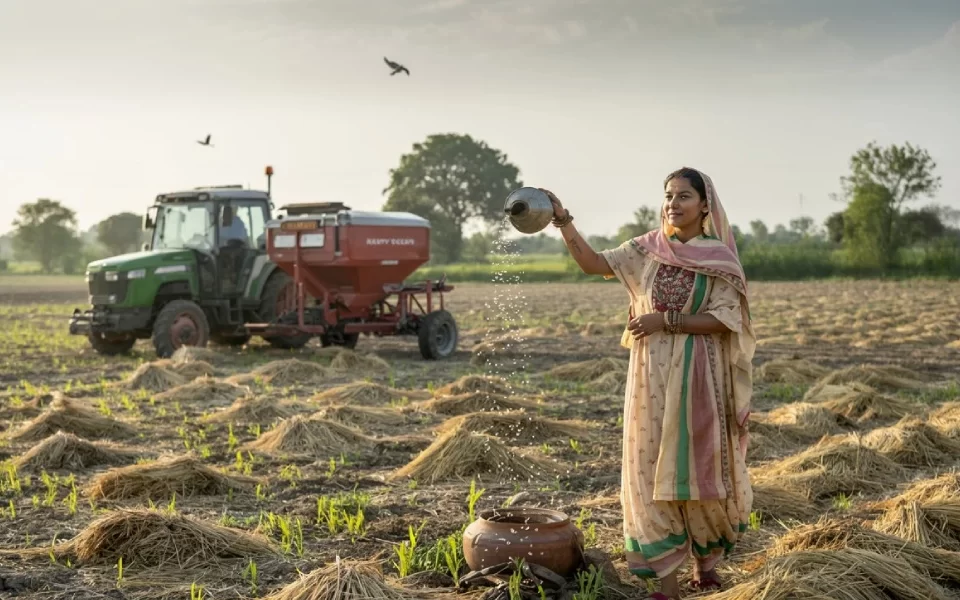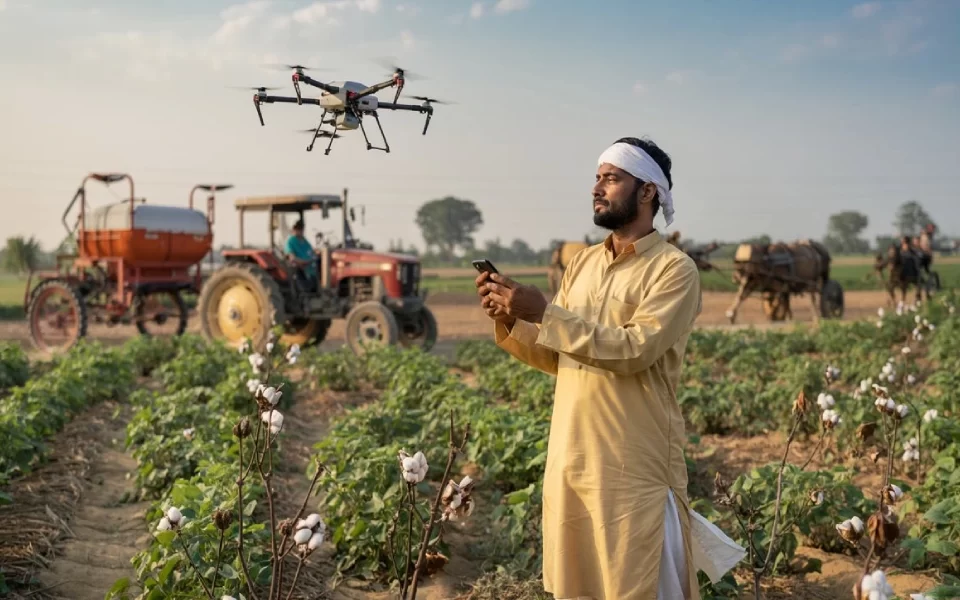
Assessing Agri Drone Viability in India
April 22, 2025
No-Burn Agriculture
April 22, 2025Harnessing Genetic Engineering for Enhanced Plant Virus Resistance: Strategies And Innovations
- Tanisha Gupta: PhD Scholar, Department of Plant Pathology, Punjab Agricultural University, Ludhiana, Punjab
- Isha: MSc Student, Department of Microbiology, Punjab Agricultural University, Ludhiana, Punjab
- Manpreet Kaur: PhD Scholar, Department of Botany, Punjab Agricultural University, Ludhiana, Punjab
The increase in grain production is not keeping pace with the growth of the world’s population, leading to a reduction in the amount of grain produced per person globally over the last twenty years. Plant viruses are a major factor in reducing both the amount and quality of crops, which threatens the stability of the world’s food supply. Therefore, it is essential to improve plants’ natural ability to resist viral infections through genetic improvements to ensure the sustainability of farming. Recent advancements in plant genetic engineering have opened up innovative and effective approaches to controlling and preventing viral diseases in crops. These new methods offer hope for more resilient and productive agriculture in the face of ongoing viral threats. Focusing on these strategies could significantly contribute to securing the global food supply. Ultimately, the integration of genetic engineering techniques to enhance virus resistance in plants is vital for addressing the challenges posed by viral diseases to crop production. This approach not only aims to increase crop yields but also to improve the nutritional quality, thereby ensuring food security for a growing global population. Further research and development in this area are essential to harness the full potential of these strategies.
VIRUS THREAT
Over the last twenty years, the world’s population has increased by over 25%, and projections estimate a rise from 7.7 billion in 2019 to around 10 billion by 2050 (Tilman et al 2011). In addition to limitations in available land and water, global food production is also hampered by pests and diseases. Viral diseases are a major source of stress, causing worldwide crop yield reductions of up to 40% and significantly impacting agricultural productivity and quality (Awan et al 2023). Plant viruses pose a substantial threat to agricultural systems, jeopardizing global food security, particularly with the ongoing population growth. Traditional chemical controls have proven inadequate in addressing this challenge. Consequently, molecular techniques aimed at fostering adaptive immunity have arisen as a viable and practical approach to safeguarding crops against viral diseases and ensuring food security.
GENETIC ENGINEERING
Conventional breeding is crucial for improving crops, but it typically requires growing and evaluating large populations over several generations, making it a lengthy and labor-intensive process. Genetic engineering, which involves the artificial manipulation, modification, and recombination of DNA or other nucleic acid molecules to alter an organism or population, offers several advantages over traditional breeding methods.
STRATEGIES FOR ENGINEERING VIRUS RESISTANCE
- Virus Resistance through use of non-viral genes
- Virus Resistance through Pathogen-derived Resistance (PDR)
- RNAi
- ZFNs
- TALEN’s
- CRISPR cas-9
- Ribonuclease P
- Virus resistance through non-viral genes
Introducing genes from non-viral sources can fortify organisms against viral infections. Witham et al‘s research explored the N gene’s function in Tobacco mosaic virus (TMV) resistance by inserting it into TMV-vulnerable tobacco plants using genetic engineering. These transgenic lines exhibited notable TMV resistance, shown by lower viral levels and the clear start of Hypersensitive Response (HR) after TMV exposure. Further examination revealed increased activity of pathogenesis-related (PR) genes and higher levels of salicylic acid, both indicative of Systemic Acquired Resistance (SAR) activation. The study also emphasized that the N-mediated response functions within an intricate signalling network. This network necessitates the synchronized activity of downstream elements, such as Enhanced Disease Susceptibility 1 (EDS1) and Non expressor of Pathogenesis-Related Genes 1 (NPR1).
- Virus Resistance through Pathogen-derived Resistance (PDR)
In 1985, Sanford and Johnston introduced the idea of pathogen-derived resistance (PDR), suggesting that incorporating pathogen genes into plants could reduce the harmfulness of the pathogens (Sanford and Johnston, 1985). In 1986, the Beachy lab demonstrated this concept by making tobacco plants resistant to the Tobacco mosaic virus (TMV) by adding genes that produce the virus’s coat protein (CP). Sanford and Johnston’s PDR theory posited that plants could defend themselves by expressing genetic components of the pathogens attacking them, disrupting the pathogens’ ability to cause disease. This innovative approach aimed to utilize the pathogen’s own genetic material against itself, offering a novel strategy for plant protection.The work by the Beachy lab in 1986 provided the first experimental evidence supporting the PDR concept. By introducing viral coat protein genes into tobacco plants, they successfully conferred resistance to TMV, marking a significant breakthrough in plant biotechnology and disease management.
- RNA Silencing
In 1990, scientists first observed RNA silencing in plants (Napoli et al 1990). RNA interference (RNAi) is now a robust tool for controlling plant viruses. It leverages a plant’s inherent RNA silencing system. RNAi works by creating double-stranded RNA (dsRNA) that the plant processes into small interfering RNAs (siRNAs) using the RNA-induced silencing complex (RISC). These siRNAs then direct RISC to destroy viral RNA, thus halting the virus’s ability to replicate and spread. RNAi is especially useful against RNA viruses but can also target DNA viruses if they have an RNA phase in their replication. RNAi-based methods have found considerable success in agriculture. Examples include Rainbow and SunUp papayas, which are genetically modified with RNAi to withstand the Papaya Ringspot Virus (PRSV) and are commonly grown. Squash (Freedom II) and potatoes have also been altered to fight off viral diseases using similar techniques.
- ZFN- or TALEN-based resistance against viruses
Genome editing is considered as a novel methodology that arose ten years prior, facilitates the manipulation of genetic material within diverse cell types and organisms. Zinc finger nucleases (ZFNs) and transcription activator-like effector nucleases (TALENs) represented the initial tools in genome editing technology. ZFNs and TALENs are composite proteins. They are engineered by combining a DNA-binding domain (DBD), derived from either a zinc finger protein or a transcription activator-like effector, with the FokI enzyme’s non-specific cleavage domain. This innovative approach enabled scientists to target and modify specific DNA sequences with greater precision and efficiency, revolutionizing genetic research and opening new avenues for therapeutic interventions.
- e) CRISPR Cas-9
The CRISPR/Cas system is an adaptive immune mechanism found in bacteria and archaea. It defends against foreign invaders like plasmids or viruses by targeting and cutting their DNA. This system allows these organisms to eliminate the threat of foreign genetic material (Bhaya et al 2011).
- f) RNase P
One of the primary difficulties facing the 21st century is ensuring adequate food production for a quickly expanding global population, especially as arable land diminishes and environmental conditions evolve. This situation demands innovative solutions to meet rising food demands sustainably. Ribonuclease P, known as RNase P, functions as an endonuclease that performs a crucial function in the processing of precursor transfer RNA (tRNA) molecules. Specifically, it is essential for the maturation of tRNA by cleaving the precursor molecule at the 5′ end. In summary, global food security is threatened by population growth, land scarcity, and environmental change, requiring focus on sustainable solutions; RNase P is an essential enzyme in tRNA maturation, highlighting its importance in molecular biology.
CONCLUSION
The seminar highlighted strong proof that genetic engineering is an effective solution for fighting plant viruses. It clearly showed the shortcomings of old methods and the critical need for new solutions to deal with the economic and food security problems caused by these diseases. Genetic engineering provides a robust set of tools for creating virus-resistant crops, utilizing methods such as RNA interference (RNAi), Zinc Finger Nucleases (ZFNs), Transcription Activator-Like Effector Nucleases (TALENs), and especially Clustered Regularly Interspaced Short Palindromic Repeats (CRISPR)-associated protein (Cas) systems. The presented case studies displayed the successful use of these techniques in different types of plants. These examples emphasized the opportunity to develop resistance that is both long-lasting and effective against a wide range of viruses.
REFERNECES
- Awan, M.J.A., Akram, A., Amin, I. and Mansoor, S., 2023. Viral vectors as carriers of genome-editing reagents. Trends in Plant Science, 28(9), pp.981-983.
- Tilman, D., Balzer, C., Hill, J. and Befort, B.L. (2011) Global food demand and the sustainable intensification of agriculture. Proc. Natl Acad. Sci. 108, 20260–20264.
- Bhaya, D., Davison, M. and Barrangou, R., 2011. CRISPR-Cas systems in bacteria and archaea: versatile small RNAs for adaptive defense and regulation. Annual review of genetics, 45(1), pp.273-297.
- Napoli, C., Lemieux, C., Jorgensen, R., 1990. Introduction of a Chimeric Chalcone Synthase gene into petunia results in reversible co-suppression of homologous genes in trans. Plant Cell 2, 279–289.
- Sanford, J.C. and Johnston, S.A., 1985. The concept of parasite-derived resistance—deriving resistance genes from the parasite’s own genome. Journal of Theoretical Biology, 113(2), pp.395-405.
- Whitham, S., Dinesh-Kumar, S.P., Choi, D., Hehl, R., Corr, C. and Baker, B., 1994. The product of the tobacco mosaic virus resistance gene N: similarity to toll and the interleukin-1 receptor. Cell, 78(6), pp.1101-1115.





